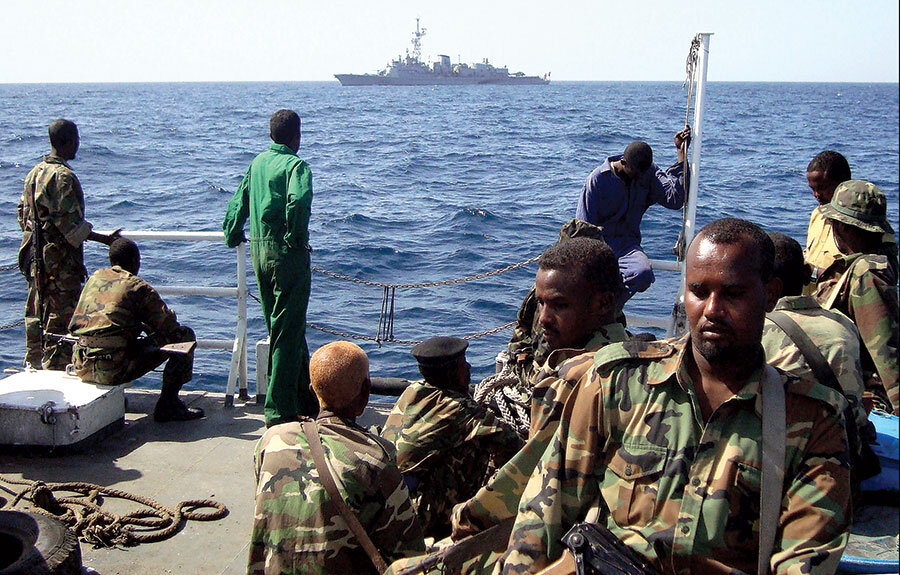Captain Phillips strikes back: Off Horn of Africa, pirates go bye-bye
Loading...
| Mombasa, Kenya
Three years ago, Isse Yuluh’s pirate gang hijacked a yacht being sailed around the world by a Danish family with three teens. The Danes were eventually freed for a ransom of $3 million.
Mr. Yuluh went to sea again. This time he returned to his beachfront base in northern Somalia with a Liberian-flagged oil tanker and an Emirati chemicals carrier, and their 48 crew members, in tow. After 10 months of negotiations and a handover of $12 million, all were released.
But despite being one of Somalia’s most feared and wealthiest gang leaders, Yuluh announced in May that he had “renounced piracy” and would tell his “fellow comrades to leave this dirty business, too.”
Yuluh is not the first and not the only pirate to quit. Mohamed Abdi Hassan, another notorious pirate nicknamed Afweyne, or “Big Mouth,” said earlier he was getting out of the game.
Things are changing in East Africa’s high-profile pirate business: A combination of greater force at sea and swifter justice on land means the bottom has fallen out of the kind of Somali piracy vividly depicted in “Captain Phillips,” the 2013 film about the hijacking of the Maersk Alabama.
In 2011 at the height of piracy, 237 attacks took place in the zone of the Horn of Africa, the Red Sea, and the northwest Indian Ocean. So far in 2014, there have been seven attacks, all of which failed, according to the International Maritime Bureau.
The number of pirate hostages has also dropped, from 1,206 in 2011 to 38 today.
In June, 11 sailors from Bangladesh, Sri Lanka, Iran, and India were freed after nearly four years, with little or no ransom paid.
“With a few very small exceptions, we’ve had two years now without any successful piracy attacks,” says Alan Cole, regional coordinator of the maritime crime program for the United Nations Office on Drugs and Crime (UNODC).
“What’s happened is that the odds of success for the pirates have dropped, and it’s become an increasingly hazardous business to be in,” Mr. Cole adds. “The chance of getting killed or captured is pretty high now, and watching so many men disappear off over the horizon and not coming back does suppress interest in this as a career path.”
To be sure, security analysts caution that the shipping industry has taken these favorable outcomes as a reason to reduce expensive antipiracy measures. For their part, the pirates say they are simply waiting for international vigilance to slacken, at which point they will come roaring back.
The Maersk Alabama
When a skiff carrying a handful of menacing armed men swung alongside the Maersk Alabama in 2009, piracy was the best job going for a young Somali.
That hijacking, in part because of the movie that followed, is the highest-profile such attack that is familiar to Americans. But it was only one of hundreds.
Somali pirate methods have been straightforward for much of the past decade: Gangs that gathered on land and shore were financed by faceless kingpins, mostly in Kenya or the United Arab Emirates. The gangs put to sea in “mother ships” stocked with many weeks’ worth of food, water, fuel, and weapons, towing litters of smaller skiffs behind them.
Once a potential target was sighted, often hundreds of miles from Somalia’s shores, the skiffs were launched and would speed to the slow-moving prize ahead. Until recently, most commercial ships were undefended and pirates could easily board them.
Then, the captured ships would be sailed to Somali waters to be followed by the first calls for ransom to owners or family. Everything captured was monetized – crew, cargo, and vessels. Hostages were mostly well treated and released without harm when an agreed-upon ransom was paid.
Typically, the pirate gang then lived large on land for a week or two off their spoils, then put to sea again. The pickings were rich. Dozens of large container vessels, cargo ships, and oil tankers representing a chunk of global trade pass each day through the Red Sea via the Suez Canal on journeys to and from Asia and Europe.
Firhan Ali, a pirate who now finds himself unemployed, can testify from personal experience that these were “the good days.”
He went to sea a dozen times, and was involved in five successful hijackings, including that of a Greek oil tanker he refuses to name. The Monitor talked with him by phone from the Somali town of Galkayo.
Today, Mr. Ali and his former comrades-in-arms say things are very different. “Life is pretty bad now,” Ali says. “What used to be my daily income is now my monthly income. It’s all about struggle to make ends meet. During the heydays, none of us expected such an inferior life could come back.”
What has changed: The world has fought back. Three coordinated international naval forces run antipiracy patrols off Somalia.
One is the US-led Combined Task Force 151, with navies from six nations. The second, Operation Atalanta of the European Union Naval Force, has a special mandate to protect aid shipments to Somalia. The third flotilla is NATO’s Operation Ocean Shield.
Across the three deployments, dozens of warships from more than 40 countries have been involved. Patrols can include vessels from otherwise antagonistic nations: South Korea and North Korea have taken part, as have Ukraine and Russia. At any one time, an average of 20 warships are at sea.
Changes have occurred on land, too. Most important, justice systems in Indian Ocean countries including Kenya and the Seychelles have been boosted so their courts can process suspected pirates and their prisons can host them while they serve their sentences.
In Somalia, the UNODC has coordinated international efforts to refurbish dilapidated prisons in the northern city of Hargeisa, capital of semiautonomous Somaliland, and in neighboring Puntland.
Today, 1,350 people convicted of connections to piracy off Somalia are in jail in 21 countries, according to the UNODC.
Warning shots
Yet by far the most successful tactic contributing to the drop in successful attacks has been sending commercial ships out to sea past Somalia with armed private security on board. [See related interview here.]
Teams of three or four guards – usually former British, American, South African, or Russian military – join vessels for the few days that they will be in what is known as the “high-risk zone” off the Horn of Africa.
For most, the passage is routine. But if a suspicious skiff approaches, under new “best practices” that most firms follow, they have a series of protocols designed to thwart a hijacking. Some are simple. Captains increase speed, trying to accelerate away or churn up a wake that is tough for a small speedboat to navigate. Decks are festooned with razor wire or electric fences to deter boarding. Powerful sonic devices have been used to repel pirates with directed, unbearable noise.
If a skiff continues to advance, security guards first show their weapons, then fire warning shots, or as a very last resort, use lethal force.
“It’s just not worth their bother coming after a vessel with armed security, if they can peel away and go and find someone else without,” says Conrad Thorpe, chief executive officer of Salama Fikira, a Kenya-based maritime security company.
Ali, the jobless pirate, confirms that the combined effect of prosecutions, navies, and security is keeping him ashore. He has returned to his former job as a security guard in Galkayo.
“Because of frequent arrests of some of our top-notch guys, which disabled our coordination, hijackings have stopped,” he says. “Every attempt ended up losing men and money. In the end, it looked like we were flogging a dying horse, and that discouraged everybody. Even our investors have lost hope. Enemy warships are watching every corner of the sea, and many of our heroes are still in jails.”
Chillingly, though, Ali says he and his friends are not finished. “We are still eyeing the waters,” he says. “Chances will come. I’m very much in no doubt those good days will come back. It’s very hard for now, but after some coordination, we shall return, and we will be stronger.”
These are not fanciful boasts. Pottengal Mukundan, the International Maritime Bureau director, says the fact that there were still occasional attempted hijackings showed that “the threat of Somali piracy is still clearly evident.”
“There can therefore be no room for complacency as it will take only one successful Somali hijacking for the business model to return,” he says.
Signs are emerging that firms may be letting down their guard. Already, shipping firms are advising their captains to slow down through the high-risk zone, and to lop miles off their route by cutting closer to Somalia’s shores. Both will save money, and boost profits.
Mr. Cole of the UNODC agrees that no one can relax yet. He reckons that the essential preconditions to running a piracy business are many ships passing; people willing to pay ransoms; young men and money for boats, guns, and fuel; and a place where the police leave one alone, which is still the case despite huge efforts to reform Somalia’s security sector.
“All of that still exists in Somalia. It’s just that the odds have been stacked against [the pirates] at sea where they now have a good chance of being killed or captured,” Cole says.
“But if those odds change back again because private security backs out, or the navies back out, I can’t think of any reason why they would not come back again.” r








